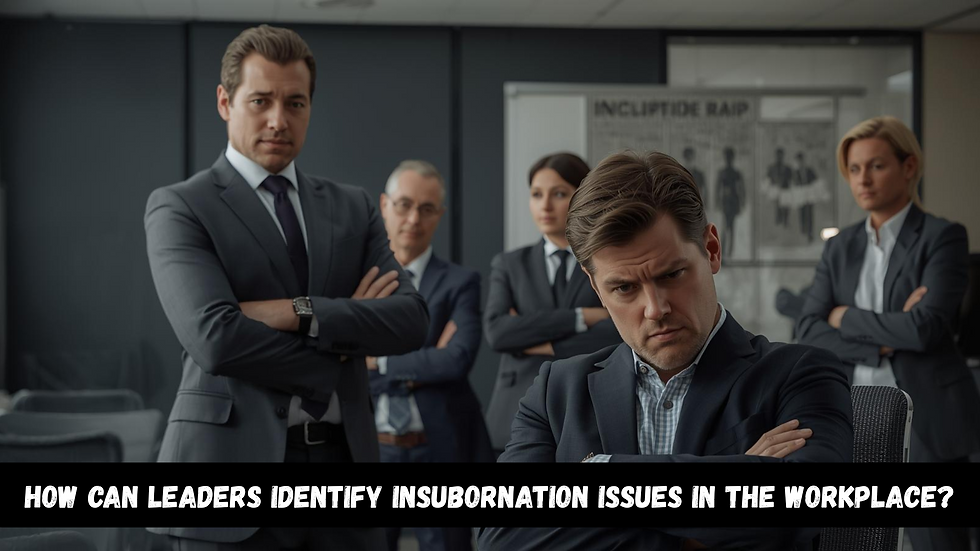How Can Leaders Identify Insubornation Issues in the Workplace?
- jamilsporer62
- Sep 28
- 3 min read

Strong leadership depends on respect and cooperation. But when employees refuse to follow legitimate instructions, it creates a serious problem known as insubornation. The key for leaders is knowing how to spot it quickly before it escalates into a bigger issue.
The answer lies in recognizing the signs, understanding the context, and applying a fair and consistent approach. Let’s break it down.
What Is Insubordination at Work?
Insubordination occurs when an employee deliberately refuses to obey a legitimate order from a supervisor or manager. It is not about healthy disagreement or constructive feedback—it’s about defiance that challenges authority and disrupts organizational harmony.
Common examples include:
Open refusal to complete assigned tasks.
Using disrespectful or aggressive language toward supervisors.
Ignoring reasonable workplace policies or procedures.
Undermining instructions in front of other employees.
Why Is Identifying Insubordination Important?

Addressing insubordination quickly is crucial because:
It protects workplace culture – Disruptive behavior left unchecked spreads negativity.
It upholds leadership credibility – Employees look to leaders for consistency and fairness.
It minimizes productivity loss – When authority is questioned, projects slow down.
It reduces legal risks – Proper documentation of insubordinate behavior is vital in case of disputes.
Key Signs Leaders Should Watch For
Recognizing insubordination requires observing both behavior and attitude. Here are some warning signs:
Repeated Refusal to Follow InstructionsIf an employee consistently ignores clear and reasonable directives, it not only signals defiance but also negatively impacts overall employee performance.
Hostile CommunicationRaised voices, sarcasm, or outright disrespect in conversations with managers.
Work Delays Without JustificationIntentional procrastination or withholding effort despite clear expectations.
Undermining Authority in PublicQuestioning or mocking a manager’s decisions in front of peers.
Pattern of ResistanceA single disagreement isn’t insubordination. The issue becomes serious when resistance is ongoing and deliberate.
How Leaders Can Handle Insubordination
Early intervention is key. Leaders should take a structured approach to ensure fairness while maintaining authority.
1. Stay Calm and Objective
Reacting emotionally can worsen the situation. Maintain professionalism and focus on facts.
2. Clarify Expectations

Sometimes employees resist because instructions are unclear. Restate the expectations and provide context.
3. Document the Behavior
Keep a record of incidents, including dates, times, and specifics. This protects both leaders and the organization.
4. Address the Issue Privately
Discuss concerns in a one-on-one setting to avoid embarrassment and defensiveness, while also linking the conversation to productivity tracking to ensure measurable improvements.
5. Offer Support if Needed

Insubordination may stem from frustration, burnout, or lack of resources. Explore whether external factors contribute to the behavior.
6. Apply Consequences Consistently
If defiance continues, enforce disciplinary measures in line with company policy whether a warning, suspension, or termination.
Preventing Insubordination in the Workplace
Prevention is always better than correction. Leaders can reduce risks by:
Setting clear roles and responsibilities from the start.
Encouraging open communication so employees feel heard.
Providing regular feedback to align expectations.
Promoting mutual respect between managers and employees.
Offering leadership training to ensure managers handle conflicts effectively.
You can aslo watch : EmpMonitor|Leading Employee Engagement and Workforce Productivity Tool
Wrapping Up
Insubornation, if left unaddressed, can erode workplace trust and productivity. Leaders must be able to identify signs such as refusal to follow instructions, disrespectful communication, and persistent resistance. Handling these situations calmly, fairly, and consistently not only resolves the issue but also strengthens team culture.
Frequently Asked Questions (FAQ)
Q1. Is disagreeing with a manager considered insubordination?
No. Constructive disagreement is healthy. Insubordination is willful refusal or disrespect.
Q2. Can insubordination lead to termination?
Yes. Severe or repeated cases can result in disciplinary action, including dismissal.
Q3. How can leaders prevent insubordination?
By setting clear expectations, encouraging dialogue, and addressing issues promptly.
Q4. What is the difference between insubordination and misconduct?
Insubordination specifically involves defying authority, while misconduct covers a broader range of inappropriate workplace behaviors.


Comments